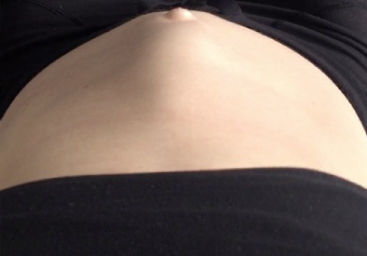
All moms experience body changes during pregnancy and postpartum. One of these is an incredibly common condition called diastasis recti, which affects up to 45% of women at six months postpartum.
Diastasis recti abdominis is the separation of your abdominal muscles. It commonly occurs during pregnancy to make room for your growing baby, but it can cause issues after birth as well.
Diastasis is the term for the separation of parts of your body that are normally not separated. One of the most common types of diastasis in the human body is diastasis recti, which is the separation of the rectus abdominis muscles — ab muscles that make up your core.
Your rectus abdominal muscles, which hold in your internal organs, run along your abdomen from your sternum to your pubic bone in two parallel bands. These muscle bands are connected by a bit of connective tissue in the middle called the linea alba. This connective tissue is where the separation occurs. All bodies have some separation due to the fact that the recti bellies are connected with this connective tissue. How wide this diastasis (or separation) is determines if you need to modify your exercise routine and daily activities.
Diastasis recti can happen to anyone, including men, babies, and children. However, most cases occur in women due to pregnancy. It’s possible to improve diastasis recti by repairing and strengthening your deep core muscles through a variety of abdominal exercises specifically targeting your transverse abdominis (TA). Moms Into Fitness will show you how!
As your uterus grows during pregnancy, organs in your body move to make room for it. As your uterus expands outward, and your organs shift to make room for baby, it adds pressure to the abdominal wall and stretches your abdominal muscles. If these muscles stretch to the point that they separate more than 2.5 centimeters along the linea alba, this is called diastasis recti.
You may have a higher risk of developing diastasis recti if you:
With that many risk factors, it’s easy to see why 33% of women report diastasis recti in their second trimester. In one study, 60% of participants had diastasis recti at six weeks postpartum, 45% of participants had a diastasis at six months postpartum, and 32% at one year postpartum. (source)
Another study of 336 women on the effects of exercise on diastasis recti in the prenatal and postnatal periods showed that exercise reduces the presence of an abdominal separation by 35%.
And in this study on the prevalence and risk factors of diastasis recti from late-pregnancy to six months postpartum, 100% of participants had a diastasis at gestational week 35 and 39% of participants still had a separation at six months postpartum.
Many women do not detect or get a diastais recti diagnosis until after baby is born. The self-test below is a starting point, but keep in mind it is not as accurate as the baby gets bigger due to fluid, the baby, the uterus moving up, etc. You might notice a possible diastasis if your belly “cones” or “domes” or you see a ridge awhile performing a traditional crunch. However, this coning could also be due to an under-cued transverse abdominis.
This is a complex question that we get often: how can I avoid diastasis recti? The reality is anyone can get diastasis recti — it’s not just a pregnancy or postpartum condition. Rather than make statements like “don’t gain too much weight in pregnancy” or “don’t do crunches,” our approach is focused much more on what you can and should do.
Our Pregnancy Programs are designed to support your body through its natural changes, and make it easier on you to return to healthy function after birth. While it may not be possible to completely prevent diastasis recti, it is possible to set yourself up for a smoother postpartum healing period and a faster return to your daily activities and fitness regimen.
A core tenant of our prenantal workout program is teaching you how to engage your tranverse abdominis — the deepest core muscles, which act as a corset around your abdomen, stabilizing the pelvis and spine. Once you know how to activate your transverse abdominis, you’re halfway there to healing.
All of our pregnancy workouts are safe for diastasis recti and will set you up for an easier postpartum recovery. Download our Prenatal & Postnatal Exercise Guide for research-backed guidance and get moving with our Pregnancy Programs.
Try our Pregnancy Programs FREE for 7 days in the Moms Into Fitness Studio. >>
You can do a self-check exercise at home after you’ve given birth as the first step to determine if you have diastasis recti.
The symptoms of this condition can vary from woman to woman. The most obvious symptom is the “bread loaf” or doming of your abdominal muscles as you roll to sit up. A postpartum pooch around your ab muscles is common, but it that doesn’t always mean you have diastasis recti. It could indicate a weak transverse abdominis or weak core. The feeling of “flabby abs” is also common.

Other symptoms of diastasis recti include:
This video features Lisa, a mom of three, with a 4-finger width diastasis reduced to a 2-finger width diastasis. Case study courtesy of the Prenatal & Postnatal Fitness Specialist Course.
Your rectus abdominis muscles (aka your six pack muscles) run along your abdomen in two parallel bands. These muscle bands are connected by a bit of connective tissue in the middle called the linea alba. Underneath lies the obliques (on the sides) and the transverse abdominis. The transverse abodminis runs horizontal and functions much like a corset. Because these muscle fibers run horizontal, exercises dedicated to the transverse abdominis help approximate the rectus abdominis, which help to minimize the gap.
Treating diastasis recti is similar for pregnancy, postpartum, and beyond. Moms Into Fitness has created comprehensive programs to help you target your transverse abdominis and create a strong, functional core.
The most common time women come to tackle diastasis recti is during their postpartum time. Even if you had your baby(ies) a while ago (or never had any), our diastasis recti guidance applies and can help you feel strong and flatten your stomach. Start by using our Core Restore program for everything you need to know about your abdominal separation and how to heal it.
With our Core Restore Program you will create a strong, functional core that can support you in all of life’s activities! You’ll improve diastasis recti, reduce pain, and feel strong with functional fitness and core-specific workouts will help you train your core from the inside out by strengthening the transverse abdominis.
Our Core Restore Program has two 4-week calendars. In the phase one calendar we are improving core stability and progressively increasing the demand so our body can handle more traditional exercise. In the phase two calendar we are loading our body with more difficulty; this includes crunches, modified planks and rotations. While this phase two calendar takes care of all your strength, cardio and flexibility needs, this is when you can add in higher impact forms of exercise like running or swimming.
Overall, the research demonstrates that women who exercise tend to improve their abdominal separations over non-exercising women. Some cases are severe enough that they require surgery; however, in most cases, you can do specific exercises designed to help heal your muscle separation.
The Moms Into Fitness Core Restore Program features 25 progressive core exercises 2-phases. All workouts have all been modified to be safe for those with diastasis recti, including flexibility, cardio, and strength training. Healthy (from toning) and supple (from stretching) muscles will treat you well!
Our Core Restore Program includes instruction on the following:
Traditional core moves like planks and crunches must wait. Instead, you need to strengthen the deep abdominal muscles, with diastasis-safe core exercises. These include:
Find videos all of these exercises in our Core Restore Program. >>
In your exercise, it’s important to avoid increasing pressure on your belly tissues, at least until you’ve created core stability. Until then avoid the following motions:
Diaphragmatic breathing helps you take complete advantage of your lungs’ capacity. Lie on your back on a flat surface with your knees bent and fingertips placed inside your hip bones. Breathe in slowly through your nose, into the diaphragm without flaring the rib cage/arching your back. As you exhale through the mouth with a “shhhh” sound, tighten your stomach muscles. You will feel this tightening of the transverse abdominis with your fingertips.
It’s not just about your abs. You must learn to activate and relax your pelvic floor muscles, which are a key piece of creating a functional core.
Do these pelvic floor exercises daily. >>
Many lower body exercises add extra pressure to the belly tissues, or add twisting/torquing/hip hinging too soon. Yes, you can twist! Yes, you can hinge at your hips! You can create strong, toned legs! BUT ONLY after you’ve established good core stability. In our Core Restore program, we combine lower body exercises with core stability.
Diastasis recti is a core muscle issue, but your entire system is connected. Weakness or tightness in one area can effect others. Our Core Restore program includes arm exercises that will help you strengthen while avoiding added pressure on your abdominal muscles.
We spend 12 hours a day upright, this is key time to keep your abdominal wall from being overstretched. With your feet parallel, stack your hip bone over your ankle bones. Stack your rib cage over your pelvis, careful not to flare the ribs. Breathe normally.
Your core/trunk is a transfer station for everything that goes on in the body. Running dramatically increases the amount of force through the core, pelvic floor, and legs. If you have diastasis recti, your structural integrity is compromised.
When running with diastasis recti, you are likely compensating, which can lead to other structural issues including knee pain, IT band pain, plantar fasciitis, low back pain, and hip flexor issues, just to name a few — not to mention increased strain through your pelvic floor. You need to address your compensations to ensure you can run with proper alignment. It’s best to seek the help of a physical therapist.
Please also avoid sprinting. When you sprint, you increase the force and rotation through your trunk muscles, which can really strain the linea alba and surrounding muscles and fascia. If you are not seeing a significant improvement after consistently doing the Core Restore Program exercises, please get in touch with a women’s health physical therapist.